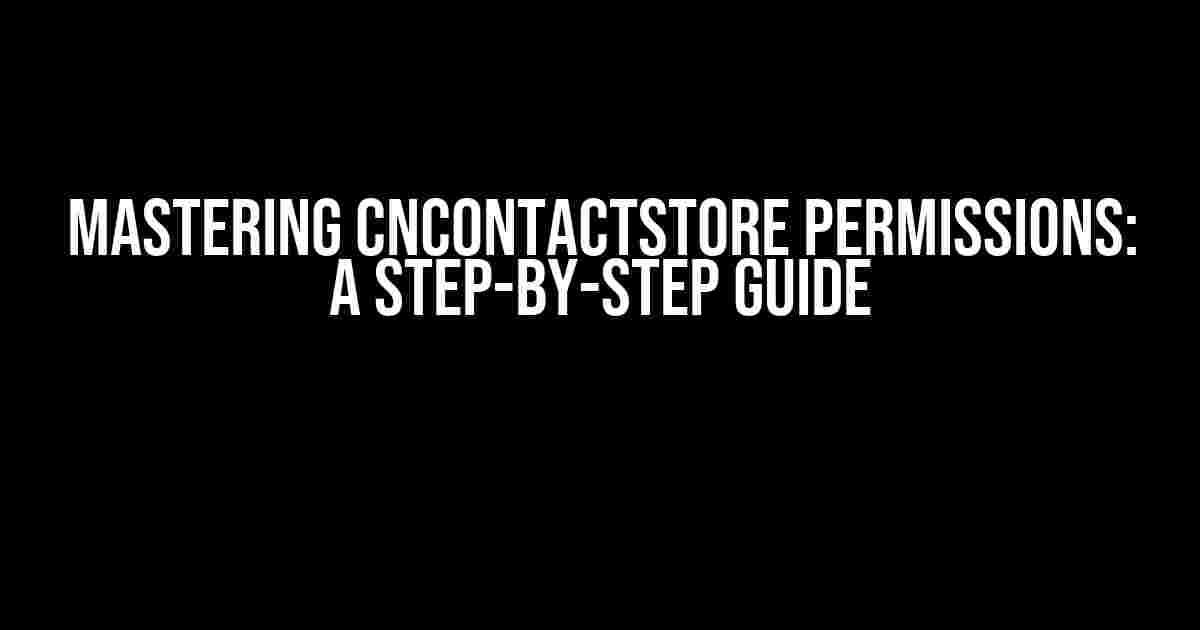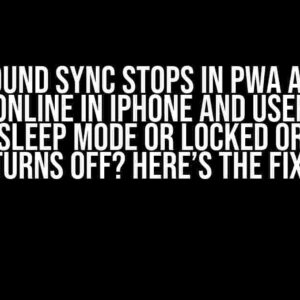As a developer, working with contact information can be a tedious task, especially when it comes to ensuring you have the correct permissions to read and write to the CNContactStore. In this article, we’ll dive into the world of permission-based contact management and provide you with a comprehensive guide on how to correctly add permissions for reading and writing to CNContactStore.
Why Permission Management Matters
Before we dive into the nitty-gritty of permission management, it’s essential to understand why it’s crucial to get it right. In a world where user data is becoming increasingly sensitive, Apple has implemented strict guidelines to ensure that apps respect user privacy. The CNContactStore is no exception, and failing to request the correct permissions can result in your app being rejected or, worse, compromised.
The Risks of Improper Permission Management
-
App Rejection: Apple is notorious for being strict when it comes to app store guidelines. Failing to request the correct permissions can result in your app being rejected, wasting valuable development time and resources.
-
Data Breaches: Improper permission management can lead to unauthorized access to sensitive user data, resulting in data breaches and damaging your app’s reputation.
-
User Trust: When users install your app, they trust you with their data. Failing to respect that trust can lead to a loss of user confidence and a negative impact on your app’s success.
Understanding CNContactStore Permissions
The CNContactStore is a critical component of the iOS contact management system. It allows apps to access and manage contact information, but it requires explicit permission from the user to do so. There are two primary permissions to focus on:
1. Reading Permissions
To read contact information from the CNContactStore, you need to request the CNContactStorePermission() with the .read permission. This permission allows your app to access the user’s contact list and retrieve information such as names, phone numbers, and email addresses.
2. Writing Permissions
To write contact information to the CNContactStore, you need to request the CNContactStorePermission() with the .write permission. This permission allows your app to create, update, or delete contact information, giving you the ability to manage contacts on behalf of the user.
Requesting Permissions
Now that we’ve covered the importance of permission management and the different types of permissions, let’s dive into the actual process of requesting permissions. To request permissions, you’ll need to follow these steps:
-
Import the
Contactsframework:import Contacts -
Request permission using the
CNContactStoreinstance:let contactStore = CNContactStore() contactStore.requestAccess(for: .contacts) { (granted, error) in if granted { // Permission granted, proceed with contact management } else { // Permission denied, handle error } }
Handling Permission Responses
Once you’ve requested permission, you need to handle the response. There are three possible outcomes:
1. Permission Granted
If the user grants permission, you can proceed with contact management. This is where you’ll execute your code to read or write to the CNContactStore.
2. Permission Denied
If the user denies permission, you need to handle the error gracefully. This may involve displaying an alert or error message to inform the user that your app requires permission to function correctly.
3. Permission Restricted
In some cases, the user may restrict your app’s access to certain contacts or features. In this scenario, you need to adapt your app’s behavior to respect the user’s restrictions.
Best Practices for Permission Management
To ensure a seamless user experience and avoid common pitfalls, follow these best practices for permission management:
-
Request permissions only when necessary: Avoid requesting permissions unnecessarily, as this can lead to friction and negatively impact the user experience.
-
Provide clear explanations: Inform users about why your app requires permission to access their contact information, and what benefits they’ll gain from granting permission.
-
Handle errors gracefully: Anticipate permission-related errors and handle them in a way that’s informative and respectful of the user’s decision.
-
Respect user restrictions: If the user restricts your app’s access to certain contacts or features, adapt your app’s behavior to respect those restrictions.
Conclusion
Mastering CNContactStore permissions is a critical aspect of developing a successful iOS app. By following the steps outlined in this article and adhering to best practices, you’ll be well on your way to creating an app that respectfully manages user contact information. Remember, permission management is an ongoing process that requires careful consideration and attention to detail. By prioritizing user trust and respecting their data, you’ll build a loyal user base and establish a reputation for developing high-quality, privacy-conscious apps.
| Permission | Description |
|---|---|
.read |
Allows your app to read contact information from the CNContactStore |
.write |
Allows your app to write contact information to the CNContactStore |
By following the guidelines outlined in this article, you’ll be able to add permissions for reading and writing to the CNContactStore, ensuring a seamless user experience and respect for user privacy.
Frequently Asked Question
Get ready to unlock the secrets of adding permissions for reading and writing to CNContactStore!
What’s the big deal about asking for permission to access contacts?
Asking for permission to access contacts is crucial because users need to be aware of the personal data your app is requesting. This transparency is essential to build trust and ensure a smooth user experience. Without permission, your app won’t be able to read or write to the contact store, which might lead to app crashes or unexpected behavior.
How do I request permission to access the contact store?
To request permission, you need to add the NSContactsUsageDescription key to your app’s Info.plist file. This key should contain a string that explains why your app needs access to the user’s contacts. Then, use the CNContactStore method requestAccess(for:completionHandler:) to request permission. This will prompt the user to grant or deny access to their contacts.
What’s the difference between reading and writing permissions?
When you request permission to access the contact store, you can specify whether you need read-only or read-write access. Read-only access allows your app to retrieve contact information, while read-write access allows your app to create, update, or delete contacts. Be mindful of the type of permission you request, as excessive permissions can be a red flag for users.
How do I handle the user’s response to the permission request?
When the user responds to the permission request, the completionHandler closure is called. You should handle the user’s response by checking the granted parameter, which indicates whether the user granted or denied access. If access is granted, you can proceed to access the contact store. If access is denied, you may want to display a message explaining why access is necessary or provide an alternative workflow.
What if the user previously denied permission to access contacts?
If the user previously denied permission, you can still request access again. However, it’s essential to provide a clear explanation of why access is necessary and how it will benefit the user. You can also direct the user to the Settings app to manually enable permission. Be respectful of the user’s decision and avoid repeatedly prompting them for permission.



